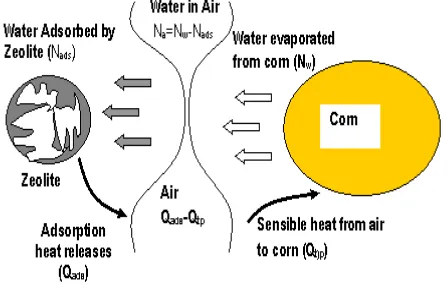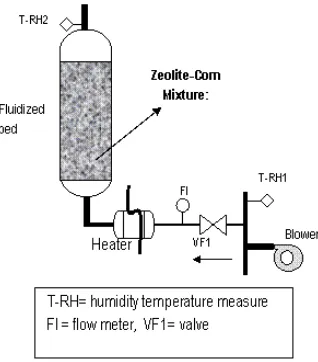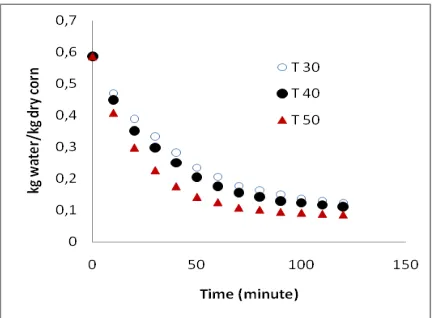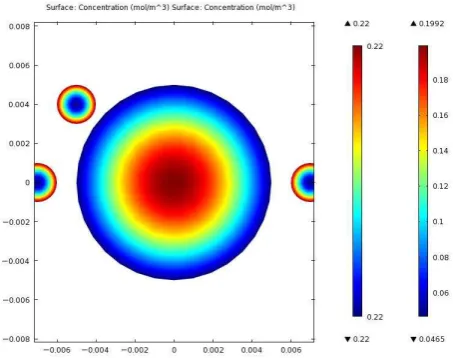The Process Transport of Drying Corn With
Mixed-Adsorption Drying
Mohamad Djaeni, Luqman Buchori
Chemical Engineering Department, Faculty of Engineering, Diponegoro University, Jl. Prof Sudharto,SH-Tembalang, Semarang INDONESIA
E-mail: [email protected], [email protected]
Abstract :
Mixed-adsorption drying with adsorptive material such as zeolite is an option to enhance the performance of drying corn. In this case, zeolite and seeds are mixed and fluidized by warm air as drying medium. The air will evaporate water from seed, and at the same time, zeolite will adsorb vapor from air. Thus, the humidity of air in dryer can be kept low in which improves the driving force for drying. So, the process can be more efficient in low or medium temperature and the corn quality can be retained.
This paper discusses the process transport of the drying formulated in two dimensional modelling. In this case, the drying rate and water diffusivity in corn was estimated with experimental data. While, the adsorption rate and diffusivity of water in zeolite as well as other important process constants was assumed based on literature. Results showed that the drying can run well and the model can describe the profiles of moisture and temperature in corn and zeolite. It can be also noted that saturation time of zeolites particles is faster than drying time of corn. It means that more zeolite is required in the mixture to keep driving force being still high.
Keywords: mixed adsorption drying, process transport, modelling, diffusivity, zeolite
1. Introduction
Corn (Zea mays L.) is one of main food resources in the world. It contains carbohydrate, protein, and edible oil [1]. Postharvest treatment such as drying is an important steps to produce high quality of corn since it determines the water content and ingredients and long life storage.
Currently, there are several drying process applied for corn, for example: direct sun drying, hot air drying, microwave, fluidization, and vacuum freeze drying. Direct sun drying is the simplest one but weather dependency for dry product quality as well as process continuity [2]. Hot-air drying is usually applied to dry corn at rotary or fluidized bed dryer. An important consideration with this process is the air temperature that increases drying rate, shortens drying time. But the higher temperature decreases corn quality. Haros et.al (2003) found that increasing temperature higher than 110oC reduces starch yield drastically [3]. In addition, the solubility indexes of albumin, globulin, and zein also decreases at higher temperature [4].
Momenzadeh, et al (2011) tried to improve the performance of fluidized bed dryer completed with microwave heating [5]. Various temperature was also observed from 30-60oC which indicated the increasing 10oC, the drying time can be reduced up to 5%. By introducing microwave heating, the drying time can be reduced up to 50% [5]. Based on the Nair, et al (2011), the microwave applied in drying corn can reduce germination [6]. However, the amount of energy usage will be another problem to be solved.
The researcher also attempted to increase the performance of fluidized corn and rice by implementing two stage dryer [7]. The process can reduce the operational temperature as well as improving the quality of corn during storage. However, the operating temperature is still higher than 60oC then the ingredients degradation has to be more considered.
Mixed-adsorption drying with water adsorbent such as zeolite or other solid adsorbents is an option to improve product quality as well as energy efficiency for fluidized. The method is firstly published by Falabella et al (1991) with bentonite clay. However, they cannot find the significant improvement [8]. Perhaps, this was due to the performance of adsorbent that was low affinity to water under drying condition. Positive results were published by Alikhan, et al (1992) and Revila et al (2006) who dried grain (corn, and seed) with zeolite [9,10]. Based on Revila et al (2006), the effect of zeolite to water removal from a product is the most superior compared to silica, alumina, sand and pillared clay [10].
vapour from air. As results, air humidity can be kept low. Moreover, operational temperature can be maintained at the certain condition due to the latent heat of adsorption. Thus, the driving force of drying can be kept high.
Zeolite is an alumino-silicate compound with tetrahedral bound linked by oxygen. Atom Al is negative that can be neralized by cation. The exchangable cation affects the adsorption ability of zeolite. Beside that, the ability is also influenced by Si/Al ratio, surface area, and size of zeolite pore [11- 13]. In Indonesia, the natural zeolite is available in market. Even, the potential of zeolite production is high [14]. However, adsorbing capacity of natural zeolite is too low rounding 0.07-0.09 gr water/gr dry zeolite. By activation using KOH or NaOH, the adsorbing capacity can be enhanced up to 0.15-0.20 gr water/gr zeolite.
This paper discusses the effect of the activated natural zeolite to dry corn. As comparison, the commercial Zeolite 3A obtained from Zeochem was also used. Each zeolite was mixed with corn at various weight percentage and temperature. Their performance in term of drying rate was observed and compared.
2. Material and Methods
2.1. Principle of Mixed-Adsorption Dryer
Figure 1 presents the phenomena of mixed-adsorption dryer with zeolite. In the process, the dry air will contact with corn. The sensible heat of air is transferred to heat up the surface of corn, and water will be evaporated (endothermic process). Parallel with the process, the zeolite having affinity to water, will adsorb water from air quickly by releasing adsorption heat (exothermic process). The heat is transferred to the air than can compensate sensible heat transferred to corn. Hence, two advantageous will be obtained from the process: temperature of air can be kept warm/medium by adsorption heat of water, and humidity of air during drying can be kept low. So, the driving force of drying can be kept high. The process occurs simultaneously and repeated several times until zeolite saturated by water.
Figure 1. Mixed-Adsorption Dryer With Zeolite
The most important point here is the operational temperature that affects the driving force of adsorption and drying as well as product quality. In the higher temperature, equilibrium moisture (water loaded capacity) both for product and zeolite is lower. In this case, the driving force for drying will be higher, but it will be lower for
adsorption. Considering to the protein and starch content in corn, the operational temperature is not more than 60oC. In this operational temperature, the adsorption capacity of zeolite is still higher. By assuming that the adsorption rate of vapor in zeolite is faster than that of desorption of water from corn, the water transport for mixed adsorption drying views the desorption rate as follows:
2
The water will desorb from inside to the surface of corn when the value of qe,p is lower than that of qw,p.
F o the p odu t p ope ties the e uili iu oistu e efe s to Oswi ’s e uatio [15]: sampling/operational time (s), qw,p is the moisture in corn at operational time, kg water per kg dry corn, kdry is drying rate of corn, s-1, aw is the water activity equals to relative humidity (RH) and Ta is air temperature (oC).
By knowing qe,p and measuring qw,p, the value of Dw at every operational temperature can be estimated.
)
D0 is a constant of diffusion (m2.s-1), B is the activation energy (J.kmole-1) divided by R (the constant of ideal gas (8.314 J.mole-1. K-1)).
2.2. Experimental set up
The research aimed to study the presence of Zeolite 3A (provided by Zeochem, Switzerland), air velocity, and operating temperature on the diffusivity of water in corn. The process was conducted in fluidized bed dryer (see Figure 2). As a sample, the sweet corn harvested from local farmer in Semarang was used with initial water content 35-40%, average bulk density 840 kg/m3, and dimensión of length, width, and thickness 8.5x6.5x2.8 mm.
In the first step, Zeolite 3A and corn were mixed with certain zeolite percentage (supposed 50%) with a total weigh of 50 gram. The mixture was then fluidized using warm air in dryer colum (ID 5 cm H 50 cm) at 40oC and linear air velocity 3 m/sec. The response, water content in corn was measured every 10 minutes during 2 hours with gravimetry. The water diffusivity was then calculated refers to the Equation 1. The procedure was repeated for a percentage of Zeolite 3A 25%, without zeolite (0%), and operating temperature 30oC and 50oC.
3. Result and Discussion.
3.1. Effect of Zeolite
Zeolite 3A give positive effects on drying corn as indicated in water content during operation. The presence of zeolites can speed up water removal as indicated in Figure 3. For example, at the same operational time the water content of corn dried with zeolite is lower than that of without zeolite (zeolite 0%). It means that the zeolite
can improve driving force for drying or keep it high by adsorbing water from the air as drying medium.
Figure 3. Comparison of water removal in corn at operational drying 40oC
3.2. Effect of Operating temperature
The temperature takes important role for both desorption and adsorption of water. At higher temperature, equilibrium moisture in materials (zeolite and corn) is lower [2, 16]. It means that water loaded in both material decreases. In this case, driving force for drying increases. In addition, the capacity of the air for evaporating water increases significantly. Hence, higher temperature, higher water can be evaporated from material (see Figure 4). Using equation 1, the higher temperature, the diffusivity of water in corn increases (see Table 1). The constant process regarding to the equation 3, can be estimated.
Table 1. Moisture diffusivity, whiteness and gel strength of carrageenan at different temperature
3.3. Water and Temperature Profile
Based on Figure 1, the water and heat transfer can be formulated in partial differential equation. Assuming that, both corn and zeolite are spheres, the accumulation of water is a function of water transport due to the
diffusion, and water uptake/release [2]:
er [16]) and vapor in air (around 3.0x10-6 m2.s-1[17]), respectively. Because the air flow is turbulance, the water in air closes to steady.
The accumulation of energy in the zeolite or corn is a function of conductive and convective heat transport, the amount of energy involved in adsorption/desorption and the energy exchange with the air:
fered
Where, is the density of solid (zeolite and corn), cps is the specific heat of corn and zeolite (kJ.kg-1.oC-1), and ks is the conductivity of material (kJ.m-1.s-1)[2,15,16,18]. For instant, it is assumed the conductivity of corn and zeolite is comparable.
The accumulation of energy in air is a function of conductive and convective heat transport and the energy exchange with the zeolite [2]: conductivity of material (kJ.m-1.s-1)[2,15,16,18]. Because the air flow is turbulance, the accumulation of heat in air closes to zero.
Using equation 4-7, the profile of water and temperature in corn and zeolite can be simulated by Femlab
Figure 5. Profile of moisture in zeolite,and corn at time 60 minutes and temperature 60oC (333.15 K)
Figures 6 presents the profiles of temperature of corn, and zeolite at operating temperature 60oC. The air introduces heat in the surface of corn. The surface temperature increases and the heat moves from the surface to the inside layer. However, for operational time 60 minutes, the temperature difference is not significant.
Figure 6. Profile of temperature in zeolite and corn at time 60 minutes and temperature 60oC (333.15 K)
4. Conclusion
Mixed-adsorption drying with adsorptive material such as zeolite can enhance the performance of drying corn. The result showed that the drying time can be faster with zeolite. In addition, transfer of water from corn to air can be positively improved. Using the estimated diffusivity, the transport of water and temperature in zeolite, corn, and air can be predicted by the partial differential model. The model can describe the profiles of moisture and temperature in corn, and zeolite. It can be also noted that saturation time of zeolites particles is faster than drying time of corn. So, more zeolite is required in the mixture to keep driving force being still high.
References
[1] George W. Dickerson (2003). Nutritional Analysis of New Mexico Blue Corn and Dent Corn Kernels. New Mexico Street University (http://aces.nmsu.edu accessed October 23, 2011)
[2] Djaeni, M. (2008), Energy efficient multistage zeolite dryer for heat sensitive products. Doctoral Thesis, Wageningen University, The Netherlands
[3] Haros, M.; Tolaba, M.P.; Suárez, C. Influence of corn drying on its quality for the wet-milling process. Journal of Food Engineering 2003, 60, 177-184
[4] Malumba, P.; Janas, S.; Masimango, T.; Sindic, M.; Deroanne, C.; Béra, F. Influence of drying temperature on the wet-milling performance and the proteins solubility indexes of corn kernels. Journal of Food Engineering 2009, 95(3), 393-399 [5] Momenzadeh, L.; Zomorodian, A.; Mowla, D. Experimental and theoretical investigation of shelled corn drying in
microwave-assisted fluidized bed dryer using artificial neural network. Food and Bioproducts Processing 2011, 89(1), 15-21
[6] Nair, G.R.; Li, Z.; Gariepy, Y., Raghavan, V. Microwave drying of corn (Zea mays L. ssp) for the seed industry. Drying Technology 2011, 29, 1291-1296
[7] Jittanit, W.; Srzednicki, G.; Driscoll, R. Corn, rice, and wheat seed dryng by two-stage concept. Drying Technology 2010, 28(6), 807-815
[8] Falabella, M.C.; Suarez, C.;Viollaz, P.E. Drying kinetics of corn with a solid adsorbent. Journal of Food Engineering 1991, 13(4), 273-283
[9] Alikhan, Z.; G.S.V. Raghavan; A.S. Mujumdar (1992), Adsorption drying of corn in zeolite granules using a rotary drum. Drying Technology, Vol. 10(3); 783-797
[10] Revilla, G.O.; T.G. Velázquez; S.L. Cortés.; S.A. Cárdenas (2006), Immersion drying of wheat using Al-PILC, zeolite, clay, and sand as particulate media. Drying Technology 24(8), 1033-1038
[11] Ozkan F.C., Ulku S., 2008, Diffusion Mechanism of Water Vapour in A Zeolitic Tuff Rich in Clinoptilolite, Journal of Thermal Analysis and Calorimetry 94, 699-702.
[12] Ackley M.W, Rege S.U., Saxena H., 2003, Application of Natural Zeolites in The Purification and Separation of Gases, Journal Microporous and Mesoporous Materials 61, 25-42.
[13] Gruszkiewics M.S., Simonson JM, Burchell TD, Cole DR, 2005, Water Adsorption and Desorption on Microporous Solids at Elevated Temperature, Journal of Thermal Analysis and Calorimetry 81, 609-615.
[14] Senda SP, Saputra H, Sholeh A, Rosjidi M, Mustafa A, 2006, Prospect of Product With Zeolite Application for Slow Release Substance and Membrane, BPPT Bulletin, Indonesia, ISSN 1410-9891
[15] Gely, M.C.; Giner, S.A. Water-corn equilibrium: Temperature dependency of the GAB model parameters and calculation of the heat of sorption. Drying Technology 2000, 18(7), 1449-1464
[16] Gorbach, A.; Stegmaier, M.; Eigenberger, G. Measurement and modeling of water vapor adsorption on zeolite 4A— Equilibria and kinetics. Adsorption 2004, 10; 29-46
[17] Montgomery, R.B. (1947). Viscosity and thermal conductivity of air and diffusivity of water/vapour in air. Journal of Meteorology 4, 193-196




